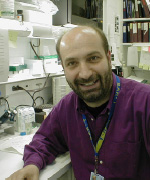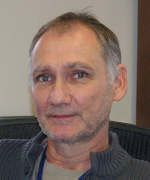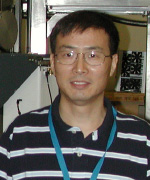Colleagues: Recently Tenured
Stefan Ambs, Ph.D., M.P.H., NCI-CCR
Senior Investigator; Head, Breast and Prostate Unit, Laboratory of Human Carcinogenesis

Education: University of Tübingen, Tübingen, Germany (M.S. in biochemistry); Institute of Toxicology, University of Würzburg, Würzburg, Germany (Ph.D. in pharmacology and toxicology); Johns Hopkins Bloomberg School of Public Health, Baltimore (M.P.H.)
Training: Postdoctoral training in NCI’s Laboratory of Human Carcinogenesis
Before coming to NIH: Senior research scientist at the Aventis Cambridge Genomics Center (Cambridge, Mass.)
Came to NIH: In 1992 through 1997 for training; returned to NCI as a tenure-track investigator in 2001
Outside interests: Traveling; doing nature photography
Research interests: We conduct molecular epidemiology studies of breast and prostate cancer using epidemiological and translational research approaches to identify risk factors and mechanisms for tumor development and progression. We focus on cancer health disparities—adverse differences in cancer incidence, prevalence, death, survivorship, and related health conditions in racial and ethnic minorities, residents of rural areas, women, children, the elderly, and persons with disabilities.
In the prostate cancer program, we are investigating population differences in tumor biology and the effect of tobacco use and biobehavioral factors on the progression of cancer. We are also evaluating the role of microRNAs in tumor biology. This research is supported by a case-control study of prostate cancer that examines risk factors among African-American and European-American men in the greater Baltimore area. In the United States, African-American men have the highest risk of any ethnic group of developing prostate cancer and more than twice the mortality rate of European-American men. While socioeconomic factors contribute to this health disparity, they do not fully explain the differences in prostate cancer incidence, aggressiveness, and mortality.
In our breast cancer research, we are looking at the influence of inflammation (in particular the role of nitric oxide biology) and common genetic variations in tumor characteristics and survival. We are also examining gene expression as well as metabolome and proteome profiles and how they relate to tumor biology in African-American and European-American patients.
We recently discovered tumor immunobiological differences between African-American and European-American patients. In the future, we will further examine the relative contribution of tumor biology to the existing survival health disparities between African-American and European-American prostate and breast cancer patients.
Frederic Glenn Barr, M.D., Ph.D., NCI-CCR
Senior Investigator; Deputy Chief, Laboratory of Pathology

Education: Williams College, Williamstown, Mass. (B.A. in chemistry); Washington University School of Medicine, St. Louis (Ph.D. in molecular biology; M.D.)
Training: Residency in anatomic pathology at the Hospital of the University of Pennsylvania (Philadelphia); postdoctoral training in genetics and molecular biology at the Children’s Hospital of Philadelphia
Before coming to NIH: Associate professor of pathology and laboratory medicine at the University of Pennsylvania School of Medicine
Came to NIH: In March 2011
Selected professional activities: Associate editor, Journal of Molecular Diagnostics; director, “Advanced Molecular Pathology” course, United States and Canadian Academy of Pathology
Outside interests: Being a “soccer dad”; watching football as a Philadelphia Eagles fan; enjoying musical theater; collecting penguin-related objects
Research interests: My laboratory uses a multidisciplinary approach to study recurrent chromosomal alterations in cancer. In particular, we focus on rhabdomyosarcoma, a cancer that is related to muscle and can occur in soft tissues anywhere in the body. Rhabdomyosarcoma is the most common soft-tissue cancer in children; in the U.S., it is diagnosed in about 250 children a year. We are investigating the genetic basis and consequences of chromosomal translocations and amplification events in this cancer. In addition, we are working with clinicians to explore whether these recurrent chromosomal alterations could serve as biomarkers for the diagnosis and management of this difficult-to-diagnose disease.
In one project, we are investigating 2;13 and 1;13 chromosomal translocations that occur in rhabdomyosarcoma. We showed that these translocations rearrange the genes PAX3 and PAX7 and juxtapose, or fuse, them with the gene FOXO1. We are examining the phenotypic effects and associated molecular changes in human muscle cells.
We are also investigating genetic events that may coincide with these fusions during rhabdomyosarcoma development. Using genome-wide screening technologies, we identified chromosomal regions that have an abnormally high copy number and are assaying those genes for corresponding expression changes and will test selected genes for phenotypic effects. We are also examining the clinical significance of these genetic changes by correlative studies from the Children’s Oncology Group, a worldwide clinical trials cooperative group supported by NCI.
Craig Blackstone, M.D., Ph.D., NINDS
Senior Investigator, Cellular Neurology Section, Neurogenetics Branch

Education: University of Chicago (B.S. in chemistry; M.S. in biochemistry and molecular biology); Johns Hopkins University School of Medicine, Baltimore (Ph.D. in neuroscience; M.D.)
Training: Neurology residency at Harvard-Longwood Neurology Program (Boston); fellowship in clinical movement disorders at Massachusetts General Hospital (Boston); postdoctoral research at Massachusetts General Hospital and Harvard Medical School
Came to NIH: In 2001
Selected professional activities: Director, NIH M.D.-Ph.D. Partnership Training Program; editorial board, Journal of Clinical Investigation; executive council, American Neurological Association
Outside interests: Playing tennis; skiing; playing with his three children
Research interests: Our laboratory investigates the cellular mechanisms underlying hereditary movement disorders. We work jointly with an active clinical program that assesses new patients with these disorders. We are particularly interested in the pathogenesis of hereditary spastic paraplegias (HSPs), which are characterized by progressive weakness and spasticity (stiffness) of the legs. HSP primarily affects the corticospinal motor axons, which are among the largest cells in the body (as long as one meter) and carry signals between the brain’s cerebral cortex and the spinal cord. Rare forms of HSPs may have additional neurological symptoms such as retinopathy, ataxia (impaired muscle coordination), cognitive impairment, and peripheral neuropathy.
About 50 genetic loci for HSP have been described and 20 genes identified. We are investigating the functions of the disease genes’ proteins at the cellular level and in animal models. We have determined that the most common forms of HSPs are due to mutations in genes that encode proteins that help shape the endoplasmic reticulum (a large membranous organelle within cells) into a tubular network. Our current studies focus on both pathogenic mechanisms and fundamental aspects of how organelles, such as the endoplasmic reticulum, are shaped and distributed within cells. The common cellular pathogenic themes that are emerging will likely present novel targets for therapeutic intervention.
Antonello Bonci, M.D., NIDA
Scientific Director, NIDA Intramural Research Program

Education: Catholic University of the Sacred Heart School of Medicine, Rome (M.D.)
Training: Residency in neurology at the School of Neurology, University of Rome Tor Vergata (Rome); postdoctoral work at the Vollum Institute for Advanced Biomedical Research (Portland, Ore.)
Before coming to NIH: Professor of neurology and holder of the Howard J. Weinberger Endowed Chair in Addiction Research at the University of California, San Francisco (UCSF); associate director of extramural affairs at the Ernest Gallo Clinic and Research Center at UCSF
Came to NIH: In August 2010
Outside interests: Playing cello and trying to learn all the Bach suites for cello; enjoying art and literature; bicycling through the beautiful back roads of Maryland; playing tennis
Research interests: My research has focused on the long-term effects of drug exposure on the brain. Before I came to NIH, my lab was the first to demonstrate that drugs of abuse, such as cocaine, modify the strength of the connections between neurons. This finding cast a new light on the phenomenon of drug addiction, which could now be seen as a process of maladaptive learning. This new understanding in turn helped explain why drug taking can often become an automatic, compulsive behavior.
Chronic exposure to drugs of abuse causes several cellular and behavioral adaptations such as tolerance, dependence, and sensitization. My laboratory aims to understand the synaptic properties of neurons in brain areas—such as the ventral tegmental area (located in the midbrain), the nucleus accumbens (located in the forebrain), and the prefrontal cortex—that are involved in drug addiction. My laboratory was the first to demonstrate that drugs of abuse produce a form of synaptic plasticity called long-term potentiation. We apply electrophysiological, optogenetic (combining optical and genetic techniques to probe neural circuits at high speed), molecular, and behavioral approaches to elucidate the long-term effects of chronic administration of drugs of abuse such as cocaine and alcohol. Understanding the basic synaptic mechanisms that underlie the long-term effects of these drugs will likely open new avenues for therapeutic strategies for substance-use disorders.
Carsten Bönnemann, M.D., NINDS
Senior Investigator; Chief, Neuromuscular and Neurogenetic Disorders of Childhood Section, Neurogenetics Branch

Education: Medical school at Albert Ludwig University of Freiburg, Freiburg im Breisgau, Germany (M.D.)
Training: Residencies in pediatrics at Altona Children’s Hospital (Hamburg) and University Hospital Göttingen (Germany); residency in neurology/pediatric neurology at Massachusetts General Hospital and Harvard Medical School (Boston); postdoctoral research in neuromuscular genetics at Children’s Hospital Boston/Harvard Medical School
Before coming to NIH: Assistant professor of pediatrics and of neurology at the Perelman School of Medicine at the University of Pennsylvania (Philadelphia); attending physician and co-director of the Neuromuscular Program and director of the Neurogenetics Clinic at the Children’s Hospital of Philadelphia (Philadelphia)
Came to NIH: In August 2010
Selected professional activities: Member of the executive board of the World Muscle Society; adjunct associate professor, Perelman School of Medicine at the University of Pennsylvania; adjunct investigator, NHGRI
Outside interests: Playing the viola da gamba; drawing; cooking
Research interests: My clinical and laboratory interests focus on genetically caused neuromuscular disorders of childhood. In my clinical practice at Children’s Hospital of Philadelphia and in my ongoing clinical practice at NIH, my efforts have been devoted to properly diagnosing children with complex neuromuscular and neurogenetic conditions.
In my clinical work, we use next-generation genomic tools to identify new genetic entities as well as to carefully establish phenotypic spectra and the natural history of known genetic entities. Our focus is on early-onset muscle disease including the congenital myopathies, congenital muscular dystrophies, and reducing-body myopathy (a disorder characterized by progressive weakness). My lab recently identified the causative gene for reducing-body myopathy.
In our basic research, we explore the role that the interactions between muscle and its extracellular matrix play in development, maintenance, and regeneration of voluntary muscle. We also look at how these interactions are perturbed in muscular dystrophy and other muscle disorders. Our overriding goal—in both the lab and the clinic—is to define opportunities for therapeutic interventions for patients who are affected by congenital muscle disorders.
Christian Grillon, Ph.D., NIMH
Senior Investigator; Section Chief, Neurobiology of Fear and Anxiety

Education: University Jussieu, Paris, France (M.A. in biology); University of Paris XI (Paris-Sud 11 University), Orsay, France (Ph.D. in neuroscience and behavior)
Training: Postdoctoral training at the University of California at Irvine and the University of California at San Diego
Before coming to NIH: Associate professor of psychiatry at Yale University School of Medicine (New Haven, Conn.)
Came to NIH: In 2001
Selected professional activities: Assisting in scientific reviews; associate or consulting editor for several journals
Outside interests: Traveling; jogging
Research interests: My research focuses on the neurobiology of anxiety and anxiety disorders and the psychophysiology of emotion. I am interested in contrasting the fear-spectrum disorders, such as simple phobia and social anxiety disorder, and the anxiety-spectrum disorders, such as generalized anxiety disorder. I examine defense mechanisms that mediate fear and anxiety in humans. Fear and anxiety can be studied by exposing subjects to different classes of threats. Responses to threats entail distinct cognitive, emotional, and behavioral processes.
For example, an imminent threat evokes a phasic fear response, which is an active coping mechanism characterized by fight or flight, while a distal or uncertain threat generates a more persistent state of anxious apprehension and hypervigilance. I use a multiperspective strategy based on psychophysiology to obtain objective measures of aversive states, affective neuroscience to understand the interaction between aversive states and cognitive and emotional processes, psychopharmacology to identify how anti-anxiety drugs work and to screen candidate anxiolytic compounds, and neuroimaging to map the neural structures underlying fear and anxiety. Elucidating the pathophysiological mechanisms is a prerequisite for better treatment for and classification of anxiety disorders.
Pengnian Charles Lin, Ph.D., NCI-CCR
Senior Investigator, Head, Vascular Biology Section, Mouse Cancer Genetics Program

Education: Beijing Normal University, Beijing (B.S. in biology); Peking Union Medical College (Institute of Chinese Medical Sciences), Beijing (Ph.D. in cell and molecular biology)
Training: Postdoctoral training at Duke University (Durham, N.C.)
Before coming to NIH: Associate professor of cancer biology, radiation oncology, and cell and developmental biology at Vanderbilt University School of Medicine (Nashville, Tenn.)
Came to NIH: In August 2010
Selected professional activities: Member of several study sections as grant reviewer for national and international funding agencies
Outside interests: Spending time with family and two sons; playing tennis and ping-pong
Research interests: The vascular system plays a vital role in the progression of many debilitating diseases including cancer, diabetes, and heart disease. Understanding the molecular mechanisms of vascular biology is critical. Our research centers on the mechanisms that govern angiogenesis (blood vessel formation) and vascular homeostasis in cancer. During normal development, vascular networks form to satisfy the metabolic demands of tissue growth. When we reach adulthood, the vascular endothelium becomes quiescent. Under disease conditions, however, this delicate balance is disturbed and the endothelium is reactivated.
Understanding what distinguishes physiological angiogenesis during normal growth from pathological angiogenesis in diseases has implications for developing therapeutic interventions. We believe that the major difference is inflammation. Our working hypothesis is that tissue injury leads to inflammation, which then triggers pathological angiogenesis. We combine genetic and biochemical approaches to investigate the interaction between inflammation and pathological angiogenesis. These approaches may have the potential to preferentially target angiogenesis in disease and spare normal blood vessels.
Our current research explores how myeloid-derived suppresser cells regulate the tumor microenvironment with a focus on angiogenesis and lymphangiogenesis; the role of vascular integrity and endothelial-to-mesenchymal transformation in tumor progression; and the genetic differences in vasculature between humans and other species.
Tonja Nansel, B.S.N., Ph.D., NICHD
Senior Investigator, Prevention Research Branch

Education: Fort Hays State University, Hays, Kansas (B.S.N. Nursing); Wichita State University, Wichita, Kansas (Ph.D. community/clinical psychology)
Training: Postdoctoral training in NICHD’s Prevention Research Branch
Came to NIH: In 1998 for postdoctoral training; became tenure-track investigator in 2001
Selected professional activities: Previous co-president and current treasurer of the Behavioral Research in Diabetes Group Exchange
Outside interests: Dog rescue and training (dog foster-parenting); gardening; healthful eating; doing yoga; hiking; skydiving; scuba diving; being a fan of her opera-star spouse
Research interests: I am interested in integrating prevention and health-promotion intervention strategies to manage and prevent chronic illness. My research is on type 1 diabetes in children and how best to help them and their families manage the disease. In particular we are looking at the influence of family, social, and behavioral variables on diabetes self-management during adolescence, a time when young people’s adherence to dietary regimens and their ability to manage glycemic control typically worsen. We have identified behavioral strategies that may help prevent the deterioration in disease management during this developmental transition period. We are exploring how to facilitate healthful eating by testing a family-based program to increase the consumption of nutrient-dense whole foods. We will determine the program’s efficacy in promoting improved glycemic control and health outcomes and provide data that are critical for guiding dietary regimens for young people with diabetes.
In addition to our diabetes research, we are also conducting studies to determine whether tailored health communications are more effective than generic ones in preventing pediatric injuries. We have found that parents are more likely to respond to tailored messages and adopt injury prevention behaviors when the messages are delivered in the pediatric primary-care setting. Our findings may offer an innovative and efficacious way to reduce injury in young children.
Marc L. Reitman, M.D., Ph.D., NIDDK
Senior Investigator; Chief of the Diabetes, Endocrinology, and Obesity Branch

Education: Massachusetts Institute of Technology, Cambridge, Mass. (B.S. in chemistry and in life sciences); Washington University, St. Louis (M.D.; Ph.D. in molecular biology)
Training: Residency in internal medicine at Columbia Presbyterian Hospital (New York); endocrinology fellowship at NIH; postdoctoral training in regulation of gene expression in NIDDK’s Laboratory of Molecular Biology
Came to NIH: In 1986 for training; received tenure in 1999; left in 2002; returned in 2011
Before returning to NIH: Director, Clinical Research at Merck Research Laboratories (Rahway, N.J.)
Outside interests: Spending time with family; collecting and reading old books on medicine, physiology, and biochemistry
Research interests: I am interested in energy metabolism and understanding the mechanisms that regulate body weight and metabolic efficiency. Using mouse models, we investigate how metabolic rate and body temperature are regulated and test drug treatments for obesity. The expectation is that mouse research will generate hypotheses that can be followed up in a clinical setting and, conversely, that our clinical observations will spur investigations using mouse models. I am reestablishing my lab and doing studies on bombesin receptor subtype 3 (BRS-3). Mice lacking this receptor develop metabolic defects and become obese. Animal studies indicate that BRS-3 agonists may alleviate obesity. I am also interested in both clinical and basic aspects of obesity and diabetes including drug discovery and development as well as pharmacogenetics and genomics.
During my career, I have made contributions in fields ranging from glycoprotein biosynthesis, lysosomal enzyme biology, inborn errors of metabolism, globin gene regulation, chromatin structure, molecular evolution, and systems biology, to lipodystrophy, leptin, uncoupling protein–3, and clinical trial design. I am looking forward to contributing to clinical research in the NIH Clinical Center’s Metabolic Clinical Research Unit, which has state-of-the-art facilities including room calorimeters (closed rooms in which peoples’ total energy intake and expenditure can be calculated). I believe that a better understanding of the molecular mechanisms regulating body weight, metabolic efficiency, and energy homeostasis will lead to advances in the treatment of diabetes and obesity.
Yun-Xing Wang, Ph.D, NCI-CCR
Senior Investigator, Head of Protein–Nucleic Acid Interactions Section, Structural Biophysics Laboratory

Education: Jilin University, Changchun, People’s Republic of China (B.S. in polymer science); Johns Hopkins University, Baltimore (Ph.D. in chemistry)
Training: Postdoctoral training in NIDCR
Came to NIH: In 1994 for training; joined NCI in 2000
Selected professional activities: Spokesperson and main contributor on small-angle X-ray scattering for the Argonne National Laboratory’s (Argonne, Ill.) 10-year strategic plan
Outside interests: Mountain biking with his children; painting; playing badminton and table tennis
Research interests: Less than 90 percent of the human genome codes for proteins, but more than three percent is transcribed into ribonucleic acids (RNA). RNA molecules play important roles in biological processes such as the regulation of gene expression, which is important in cancer biology. Understanding the mechanisms of these processes requires knowledge of the three-dimensional (3-D) structures of these RNA molecules and participating proteins. But 3-D structures of RNAs are hard to determine even though scientists have made tremendous progress during the last decade in two of most powerful methods—X-ray crystallography and nuclear magnetic resonance (NMR) spectroscopy—for determining the structure of biomacromolecules. Our laboratory has developed a new method for the combined use of small-angle X-ray scattering and NMR spectroscopy for determining 3-D structures of RNAs in solution. We use small-angle X-ray scattering to outline the global shape of a molecule in solution and use NMR spectroscopy to identify structural details. With this combined approach, we identified the 3-D structure of a ribosome-binding structural element—a 102-residue RNA that regulates the initiation of viral translation and replication in turnip crinkle virus. Currently, we are in the process of determining the 3-D topological structures of several large RNAs that are important in human immunodeficiency virus. These 3-D structures provide important clues to the function of these RNAs.
If you have been tenured in the last year or so, The NIH Catalyst will be in touch soon to include you on these pages.
This page was last updated on Monday, May 2, 2022
